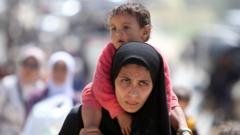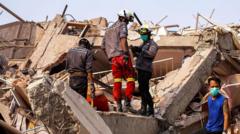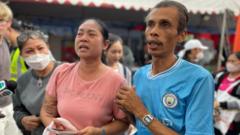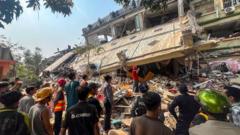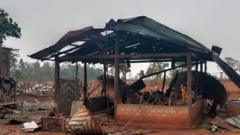As Myanmar grapples with a catastrophic earthquake that struck near Mandalay, the military government reports the death toll has reached nearly 700, with injuries exceeding 1,600. The 7.7-magnitude quake, felt across Southeast Asia, has triggered a rare plea for international aid from the junta, which is struggling with heavy sanctions and logistical hurdles in delivering humanitarian relief.
Myanmar Earthquake: Rising Death Toll and Urgent Calls for International Aid

Myanmar Earthquake: Rising Death Toll and Urgent Calls for International Aid
A devastating 7.7-magnitude earthquake near Mandalay, Myanmar has resulted in nearly 700 fatalities and over 1,600 injuries. The disaster has prompted urgent calls for international assistance amid complicated logistical challenges.
March 29, 2025, 12:58 a.m. ET
The recent 7.7-magnitude earthquake near Mandalay, Myanmar, has claimed nearly 700 lives, with more than 1,600 people reported injured, according to the country’s military government. The quake, which struck on Friday afternoon, was felt across various regions of Southeast Asia, affecting areas along the Sagaing Fault where significant destruction occurred.
In the aftermath of the quake, the military junta made an unprecedented appeal for international aid. The junta faces heavy sanctions imposed by countries including the United States and the United Kingdom, which complicate the provision of external assistance. Although U.S. President Trump indicated support for relief efforts, the extent of aid remains uncertain given previous cuts to foreign assistance.
Notably, the tremors were felt as far away as southern China, where injuries were reported in Ruili city, and in bustling Bangkok, Thailand, where a construction site experienced a building collapse. Mandalay's main hospital was overwhelmed with victims, many requiring urgent attention outdoors due to overcrowding within the facility. Satellite imagery and analysis estimate that the eventual death toll could dramatically surpass 10,000 as rescue teams continue to scramble through the debris to locate survivors.
Compounded by a long history of isolation and civil unrest, the humanitarian response in Myanmar faces daunting obstacles. The military has a history of restricting internet access to suppress dissent, making communication regarding the disaster’s true impact significantly challenging. It also raises concerns that global aid may not reach those in desperate need due to the junta's control and potential biases towards certain regions.
Furthermore, the recent seismic activity in Myanmar is a stark reminder of the country's vulnerability, as it lies in a region prone to significant geological activity. Past earthquakes have similarly wreaked havoc, leading to high casualties and extensive damage. As the situation continues to develop, the international community stands ready to respond, though the logistical realities present significant hurdles to ensuring timely and equitable assistance for all affected individuals in Myanmar.
The recent 7.7-magnitude earthquake near Mandalay, Myanmar, has claimed nearly 700 lives, with more than 1,600 people reported injured, according to the country’s military government. The quake, which struck on Friday afternoon, was felt across various regions of Southeast Asia, affecting areas along the Sagaing Fault where significant destruction occurred.
In the aftermath of the quake, the military junta made an unprecedented appeal for international aid. The junta faces heavy sanctions imposed by countries including the United States and the United Kingdom, which complicate the provision of external assistance. Although U.S. President Trump indicated support for relief efforts, the extent of aid remains uncertain given previous cuts to foreign assistance.
Notably, the tremors were felt as far away as southern China, where injuries were reported in Ruili city, and in bustling Bangkok, Thailand, where a construction site experienced a building collapse. Mandalay's main hospital was overwhelmed with victims, many requiring urgent attention outdoors due to overcrowding within the facility. Satellite imagery and analysis estimate that the eventual death toll could dramatically surpass 10,000 as rescue teams continue to scramble through the debris to locate survivors.
Compounded by a long history of isolation and civil unrest, the humanitarian response in Myanmar faces daunting obstacles. The military has a history of restricting internet access to suppress dissent, making communication regarding the disaster’s true impact significantly challenging. It also raises concerns that global aid may not reach those in desperate need due to the junta's control and potential biases towards certain regions.
Furthermore, the recent seismic activity in Myanmar is a stark reminder of the country's vulnerability, as it lies in a region prone to significant geological activity. Past earthquakes have similarly wreaked havoc, leading to high casualties and extensive damage. As the situation continues to develop, the international community stands ready to respond, though the logistical realities present significant hurdles to ensuring timely and equitable assistance for all affected individuals in Myanmar.





